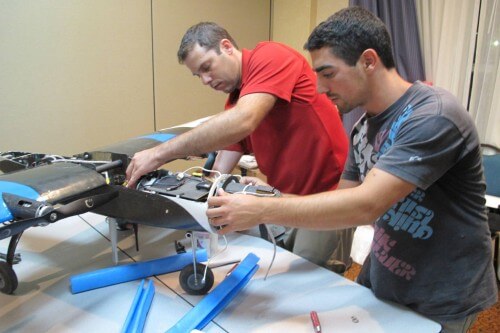The group of students from the Faculty of Aeronautics and Space Engineering and the Faculty of Electrical Engineering at the Technion developed two autonomous airborne systems for observation, identifying communication targets, dropping payloads and avoiding obstacles

A team of students from the Technion, led by Dror Artzi, Amit Aids and Iti Or, won second place in the prestigious competition of the International Association for Unmanned Aerial Vehicles (AUVSI) that took place last weekend in Maryland, USA. 55 teams from universities and colleges from around the world participated in the competition, most of them from the USA. Only 32 of them eventually reached the stage of flying the system.
The Technion team, which included students from the aeronautics and space engineering and electrical engineering faculties, developed two autonomous airborne systems that perform observation, target identification, communication transfer, dropping a charge on the target and avoiding obstacles. Advanced systems were installed in each of the aircraft, including a stabilized camera, an airborne computer for image processing, and a communication system for controlling, monitoring and transmitting images. The ground station includes a control system for monitoring the autonomous flight, collecting and processing images and a communication system for command, control and transmission of the images.
The teams were given 20 minutes to deploy the system, including the ground station. During the competition, the team presented a 26-minute flight during which it performed the tasks - autonomous navigation flight and scanning in a defined area to search for ground targets, image recognition, connection to a ground communication station, side target detection outside the flight path and figure target detection. All this while flying autonomously and transmitting the data in real time to the ground. In addition, the team members were able to autonomously avoid obstacles.
The competition also included a demonstration of the system's readiness-to-fly, for which the team received compliments from the judges. For writing an engineering document (JOURNAL PAPER) the team received the most points and was ranked first.
During the nine months leading up to the competition, the students experienced developing an overall system, manufacturing aircraft, performing complex analyzes and experiments, operating the entire system within coordinated team work (CRM) and performing an operational deployment. "We received assistance and support from several companies and organizations," said one of the project's facilitators, Dror Artzi, "including the Rafael Company, the Aerospace Industry, Elbit Systems, Ein Carmel Styrofoam, DHL, Intellitech, Intel, the Ohlendorf Foundation, yeshgo, an image processing laboratory at the Faculty of Electrical Engineering, The Faculty of Aeronautics and Space and the management of the Technion".
"The team demonstrated in the competition the high academic level of the future graduates of the Technion, and once again presented Israel's capabilities in developing integrated systems and unmanned aircraft," concluded the project leaders after the win, "this is unusual excitement for us, and we feel that our labor is rewarded." The students worked great throughout the year, and their achievement is the result of hard and diligent work. The flight and success of the system are the product of a learning process and the acquisition of engineering knowledge throughout the year."
https://recruitment.eso.org/jobs/2015_0021/?apply=true
the project team:
- Students from the Faculty of Aeronautics and Space Engineering: Shagib Yaari, Gal Delali, Niv Becher, Eliran Eyal, Chaya Rosengard, Shaia Nagar, Yevgeni Gutnik, Dodo Markovich, Ilya Lesvoi, Avishai Hasidov, Lilach Mazor and Hoya Gerti.
- Students from the Faculty of Electrical Engineering: Uri Ashur, Uri Avraham, Shlomi Busher, Dima Melchis and Michael Kolokov.

2 תגובות
Well done! A very complex achievement
YeshGo is proud to donate 2 Mobius cameras to the winning team of the Technion. Get more explanations about the competition, including a video the students produced: http://yeshgo.com/%D7%94%D7%98%D7%9B%D7%A0%D7%99%D7%95%D7%9F/